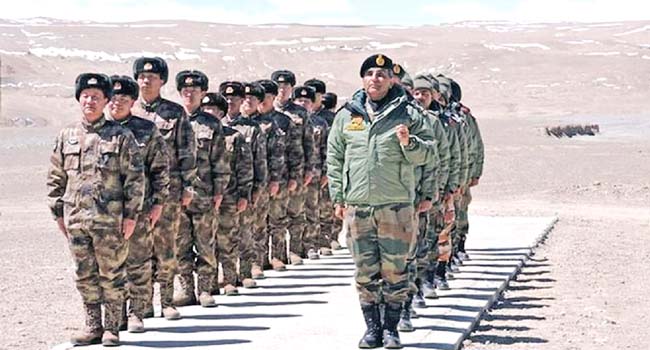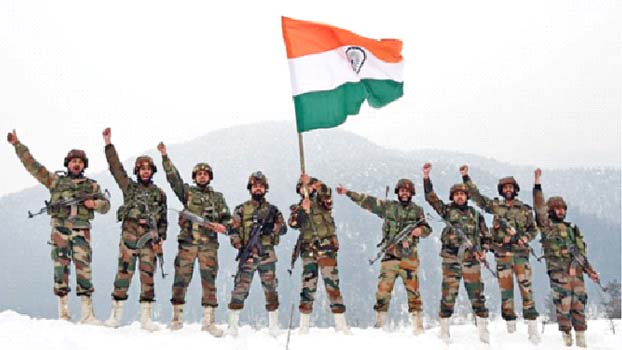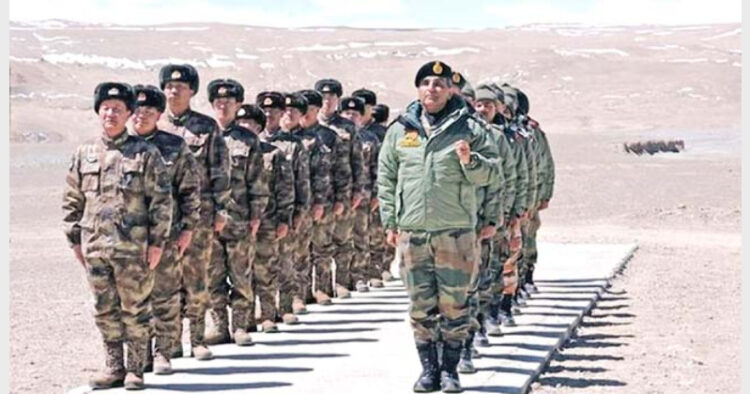China needs to realise that it is in the interest of both the nations to resolve the all outstanding boundary disputes through mutual negotiations. India cannot be browbeaten nor subverted through motivated media war because India has the capability to stand firm and resolute

Indian and Chinese armies recently held Lieutenant General-level talks in an attempt to
resolve the month-long border stand-of
A midst the continuing military stand-off in Ladakh and a series of failed bilateral meetings at varying military-diplomatic level, China embarked upon the all familiar video war releasing one video after the other showcasing China’s modernised and digitalised military prowess. It’s familiar because it’s a repeat of what China did in 2017 during the Doklam crisis as well. For instance, it released a video a couple of days before the scheduled Corps Commander level meeting. The video released by Global Times showed a duly grouped Task Force practising “infiltration drills” operating at night crossing the border with switched off lights and guided with laser to avoid detection, destruction of enroute threats by using drones, when approaching the target behind enemy lines a sniper team was deployed to destroy enemy spotlights, a fire strike team was used to neutralise the enemy’s light armoured vehicles with anti-tank rockets. Thus the enemy’s defences were neutralised and after that the task force launched the final assault on the enemy headquarters, in which vehicle-mounted infrared reconnaissance system was used to guide the troops to lock on the targets and destroy them accurately. The exercise as per the propaganda mouthpiece Global Times was done at 4700 meters simulating border with India but much farther in depth in the area of Tanggula mountains. The video had glaring mistakes apart from not displaying the timeline, the troops participating in the exercise were wearing summer combat fatigues and not the extra winter clothing essential to survive at that altitude. Doesn’t it remind the readers of some Hollywood thriller? The keen China watchers like myself, who refused to be misled by the Chinese media, exposed that China released a similar video in July 2017 at the peak of Doklam crisis. The difference being 2017 video claimed that the exercise was held at 5100 metres.
Why the Chinese media resorts to such tactics? To understand this, it is essential to understand the Chinese war-fighting strategy, “winning without fighting”. It goes to the credit of the Chinese Army that it has not depended on foreign armies to define its military doctrine but has used indigenous knowledge and experience to draft its strategy and doctrines based on the national requirement. China is a one-party state with undisputed supremacy of the Chinese Communist Party (CCP). The Chinese Armed Forces represented by People’s Liberation Army (PLA) is the Army of the Communist party and not of the state. It has a political role. Its task is to defend China’s national interest which entails providing “strategic support for consolidating the leadership of the CPC and the socialist system.” It is the legacy of Mao’s Red Army. Mao stated, “Chinese Red Army is an armed body for carrying out the political tasks of the revolution”. It is the party’s Army. The PLA, therefore, is controlled by the CCP through the Central Military Commission (CMC). As stated earlier PLA is a misnomer and represents the armed forces of China comprising Peoples Liberation Army Army (PLAA), Peoples Liberation Army Airforce (PLAAF), Peoples Liberation Army Navy (PLAN), Peoples Liberation Army Rocket Force (PLARF), Peoples Liberation Army Strategic Support Force (PLASSF), Peoples Liberation Army Joint Logistics Support Force (PLAJSF). The Chinese security doctrine, as enunciated by CMC, is referred to as “Political Warfare.”
Adhering to Sun Tzu’s dictum of “winning without waging war”, the Communist Party’s Central Committee and CMC has laid out the concept of “Three Warfares” (sanzhongzhanfa) as a set of codes for the PLA to conduct political warfare. Referred to as the “Political Work Guidelines of the People’s Liberation Army”, three warfares strategy entails: public opinion (media) warfare (yulunzhan), psychological warfare (xinlizhan), and legal warfare (faluzhan) with their main focus on; control of public opinion, psychological warfare to include blunting an adversary’s determination, a transformation of emotions, psychological guidance, collapse of (an adversary’s) organisation, psychological defence; and, restriction through the law (legal warfare).
Of the three, two have a direct bearing on subverting the enemy, playing mind games, coercion and psychological domination using different platforms. It is a subset of more widely known Information Warfare. It aims at shaping the international image of China by influencing foreign decision-makers’ perceptions and their approach towards China. It is operated by means of pre-conflict posturing of military/paramilitary forces or application of other national capabilities (diplomatic, economic, and cultural) with the intention of intimidating adversaries and encouraging acquiescence to PRC-desired outcomes. These are not used only against an adversary but also domestic population and friendly countries for building public opinion favourable to CCP and perception management. In doing so, the well-tried policy of ‘Carrot and Stick’ is scrupulously adhered to. The same is very visible in the current stand-off as well. Careful scanning of various articles, videos and tweets emanating from China related to the current stand-off bears testimony to the fact. These can easily be termed as instruments of propaganda warfare. Most of these are prepared under simulated conditions not only to scare the adversary but also for motivating own soldiers since morale is a big issue with Chinese armed forces.
“At present the world’s largest and experienced country with plateau and mountain troops is neither US, Russia nor any European powerhouse, but India”, says Chinese military expert Huang Guozhi in a Chinese military magazine. The timing and content of the article written in Mandarin is self-explanatory
With this in mind, the Central Working Committee of the CCP has given the responsibility of implementing China’s “three warfares” strategy, to the Political Work Department, after the recent organisational reforms. The Political Work Department, which is subordinate to the CMC, works in coordination with the PLA intending to create and safeguard the legitimacy of the CPC’s political power from any international as well as domestic threat.
Another facet of psychological operations is the sowing of discord and a sense of hopelessness in adversary nation’s Army and populace. Not only will this help in breaking their will to fight off the adversary’s forces and demoralise the population but also discourage resistance in case of actual conflict or mental fatigue and demoralisation in case of a long stand-off. This also helps in seeking concessions at the negotiating table. “When one defeats the enemy, it is not solely by killing the enemy, or winning a piece of ground, but is mainly in terms of cowing the enemy’s heart.” To undermine the opponent’s morale, Chinese believe in peddling information favourable to oneself through various forms of media as well as through third parties, familiar elements in the opponent’s society, and similar outlets. Fortunately, the current stand-off has exposed many such Chinese moles in our society, including veterans, columnists and defence analysts. They spared no effort to multiply the Chinese effort but were taken head-on by those who wanted the nation not to get alarmed by their alarmist and exaggerated reporting not only undermining our valiant soldiers but also creating a sense of “China Bogey” among the general public. In all fairness, they have not only been exposed but also proved wrong.

The Chinese under the misconception of coercing India launched a full-fledged ‘psyops’ campaign but had to eat humble pie in the end. Instead of breaking Indian soldiers’ will to fight, it exposed many chinks in its armour. The mirror deployment by the ground forces, air force and pro-active navy took the Chinese by surprise. Coupled with this is the firm and rock-solid politico-diplomatic stand of India that has not only rattled the Chinese but sent them a clear-cut message of “No-Nonsense” approach of the government. Commenting on the mind-games being played by China, Ram Madhav retorted, “India’s response is marked by pro-active diplomacy and strong dispositions on the LAC.”
In order to buy time, China has been insisting on a series of meetings so that it can prolong the stand-off because the early resolution would hit China’s global image badly. An important meeting was held at Moldo post (opposite Indian post of Chusul) between the two delegations led by the Corps Commanders. Before the outcome of the meeting was known openly, PLA once again resorted to mind game by releasing a video displaying China’s operational readiness, mobilisation and capability of switching combat-ready troops from one theatre command to another. A couple of days later it was revealed that both armies have agreed to disengage from a few areas and also pull back additional troops and weapon platforms deployed on their side of LAC. The intent of the video is now becoming clearer. The Indian side would have asserted to their counterparts the local superiority enjoyed by our forces in the designated areas. The video was meant as a counter but failed to have the desired impact because India is in a better position to muster a larger number of fully acclimatised combat-ready troops. Thereafter the pullback took place. Interestingly, it has now been acknowledged by a Chinese military expert Huang Guozhi when he wrote in a Chinese military magazine that “At present the world’s largest and experienced country with plateau and mountain troops is neither US, Russia nor any European powerhouse, but India”. The timing and content of the article written in Mandarin is self-explanatory. Global Times, the propaganda mouthpiece of the CCP, writes in English and is not meant for the domestic audience.
China must be thinking of emulating Sun Tzu by adopting his strategy of “winning without fighting” against India without realising that India is the land of Krishna, grand strategist and adviser like Chanakya. India cannot be browbeaten nor subverted through motivated media war because India has the capacity and capability to stand firm and resolute. China needs to realise that it is in the interest of both nations to resolve the long outstanding boundary dispute through mutual negotiations and concentrate the comprehensive national power towards building stronger economies in a post-COVID era.
(The writer is a Jammu based veteran, political analyst, columnist, security and strategic analyst. The views expressed are personal)













Comments